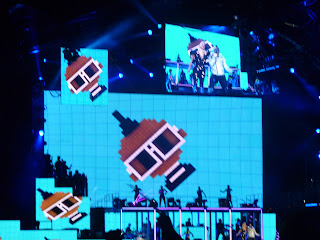Working on a live production and knowing that you set up a
lighting fixture or ran the front of house console is a great experience. During
the show or after all the work is done you feel a little proud of yourself,
even if you didn’t do the best job.
I was working on the Katinas show last week in Full Sail
Live 1 as a lighting assistant. This was my first time being a lighting assist
and it was a fun position to fill. I helped set up 4 Technobeams on boom
trusses behind the stage, 2 Mac 700 profiles, 2 Mac 500’s, and 2 Mac 600’s. I
was placing the fixtures in their locations, running power, and data cables to
them. I didn’t do any of the addressing because I wasn’t familiar with that. After
those lights were setup, there were a total of 111 lights in the rig. The 111
fixtures included movers, conventional, and stage bars. At first I was excited
to see all those lights, but I was quickly realizing that there could be too
many lights for such a small venue. I don’t know what the designer was trying
to accomplish, but I couldn’t say anything, I only had to wait and see. Before
the show the lighting designer was going through the fixtures and making cues. I
wasn’t too pleased with the lights just because I had that initial thought of
too many fixtures. I was sitting there wondering and trying to figure out what
the LD’s idea was with all these lights.
Once the show started I finally saw what he was trying to
do. It finally hit me when he played back the first cue. He was only
experimenting with the tools he had at his fingertips and he made it work. The
lights were placed well and filled everything little gap in the venue. The
lighting designer wasn’t afraid to walk into a venue with 27 moving lights and
add 18 more to create something bigger. The transitions from cue to cue were
great and the additional lights just blended well with the previous ones. From
what I saw, the lighting designer wasn’t trying to create a noticeable light
show. He was only trying to experiment with what he add and create something
great on the fly. Being apart of that experiment will only encourage me to try
new things in lighting in the future.
Special thanks to Ross Blitz and Adam Stachow.





